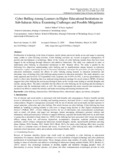| dc.contributor.author | Makori, Andrew | |
| dc.contributor.author | Agufana, Peace Byrne | |
| dc.date.accessioned | 2020-05-27T18:46:51Z | |
| dc.date.available | 2020-05-27T18:46:51Z | |
| dc.date.issued | 2020-03 | |
| dc.identifier.citation | Higher Education Studies; Vol. 10, No. 2; 2020 | en_US |
| dc.identifier.issn | 1925-4741 | |
| dc.identifier.uri | http://www.ccsenet.org/journal/index.php/hes/article/view/0/42285 | |
| dc.identifier.uri | https://www.researchgate.net/publication/339954512_Cyber_Bulling_Among_Learners_in_Higher_Educational_Institutions_in_Sub-Saharan_Africa_Examining_Challenges_and_Possible_Mitigations | |
| dc.identifier.uri | http://hdl.handle.net/123456789/4405 | |
| dc.description.abstract | Proliferation of technology in the form of internet, mobile phone and social media access and usage is exposing many youths to cyber bullying activities. Cyber bullying activities are viewed as negative consequences of growth and development in technology. Many of the victims of cyber bullying include those that have been trapped in the technology through obsessive and addictive behaviours. The study was conducted in order to understand cyber bullying in educational institutions in Sub- Saharan Africa. The study is guided by the following five objectives: understanding cyber bullying and its manifestations among learners in education institutions; explore contributing factors in education institutions; determine the prevalence of cyber bullying in education institutions; examine the effects of cyber bullying among learners in education institutions and determine ways of dealing with cyber bullying among learners in education institution. The study adopted a case study approach and involved 123 respondents with a response rate of 64% (n=192). A survey questionnaire was used to collect data. Resulting data was analysed using statistical package for social sciences (SPSS). Evidence suggests that cyber bullying has serious psychological harm on the victims some leading to suicidal thoughts and suicide, among others. The study concludes that the effects of cyber bullying are far reaching and devastating to the learners and the institutional safety as well. The study recommends that more research and awareness are needed in an effort to control this menace and make outreaching and learning institutions safe. | en_US |
| dc.language.iso | en | en_US |
| dc.publisher | Canadian Center of Science and Education | en_US |
| dc.subject | cyber bullying | en_US |
| dc.subject | characteristics | en_US |
| dc.subject | Sub-Saharan Africa | en_US |
| dc.subject | educational | en_US |
| dc.subject | impact | en_US |
| dc.subject | prevalence | en_US |
| dc.subject | mitigation | en_US |
| dc.title | Cyber Bulling Among Learners in Higher Educational Institutions in Sub-Saharan Africa: Examining Challenges and Possible Mitigations | en_US |
| dc.type | Article | en_US |

